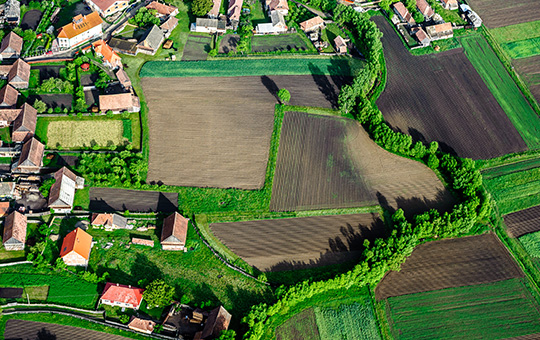Click the 'Play' button to read out loud this webpage content
The ancient Indian science of architecture is called as Vastu Shastra. This tries to lead us into the natural way of living, by being in tune with the forces of nature. Hence, nature’s five prime elements- Earth, Water, Air, Fire, and Space – play a vital role in its principles.
Here let us go through some specific Vastu aspects related to the Earth element, that is, about the plot of land meant for house construction.
The shape of a plot of land earmarked for construction of a building matters as much in Vastu, as the land itself. Regularly shaped plots are believed to be auspicious and highly suitable for house construction, while irregular ones are just otherwise. Going by the Vastu standards, it is only the square and the rectangular plots, which qualify for the ‘regular’ label, while almost all other shapes are considered irregular.

Vastu Shastra regards that vacant lands or plots too, have their energies and these flow from the North Pole to the South Pole. Known as electromagnetic forces, these positive vibrations can provide prosperity, peace, and joy to the residents living there. This energy flow, which happens from the Northeastern to the Southwestern corner of the plot, is considered the best in square plots and good in rectangular ones. This is especially so in the case of plots shaped in line with the cardinal directions, North, South, East and West, and those enclosed within boundary walls. It should be said here that it is not advisable to go for residential plots, which have the main directions in their corners.
Hence, the piece of land, which is square, that is, which has all its sides equal and corners at 90 degrees, is regarded highly beneficial for the making of a dwelling place, as it can bestow the residents with health, prosperity, progress, and tranquility. The rectangular plot that has the opposite sides equal and 90-degree corners can ensure wealth and joy. The corners of such plots have their angles in equal degrees, which provides a balance of energies flowing in these shapes and this can work to the benefit of the residents in many ways. However, plots in the shapes of triangle, hexagon, octagon, star, etc. and in other irregular patterns are all considered variously as average, unlucky, inauspicious and generally not so good for living. Same is the case with circular plots too, and circular constructions inside circular plots are said to be especially so. There could, however, be some exceptions.
There are some plots, which may as such be a square or a rectangle but may remain extended in some direction or the other. Though irregular in shape, the plot extended in the auspicious Northeast can give many benefits to the people, while extensions in other directions may produce mixed or not-so-good results.
There may also be lands in regular shapes, but these might have lost a small portion of their space in some corner or the other. Plots with such corner-losses may give results reverse of those given by the extended plots. Losing such a land-portion in the Southwest corner may prove beneficial while all other reductions may cause distress.
It is worth looking at ‘hindrances’ to the plot or house from the Vastu point of view, along with the loss of land seen above. Such obstacles are known commonly as Vedhas. These may be of many kinds but more or less remain the same, as they all prove disadvantageous to the people. There may be physical obstructions in front of the main gate or door in the form of trees, poles, etc. These are known as Dwar Vedha and cause many impediments to the people. There may be many such hindrances due to various objects or substances placed inconveniently or inappropriately in front of the entrances, and each of them will contribute negatively to the welfare of the people, in some form or the other.
Temples are holy places, there is no doubt, but when houses are present too close to them, this also causes obstacles or Vedhas, called as Devalaya Vedha, and these can impact the residents negatively. As per scriptures, residences should not be constructed anywhere near or within some 100 feet from the temple. As people will be answering their calls of nature in a zone that is considered sacred becomes an affliction that they may have to suffer. The impact may be different for the abodes of different Gods. Similarly, people also have to be extremely careful in designing their Pooja rooms inside their houses.
Along with the nearness, the shadow of the temples that may fall on the houses may also lead to obstruction called Devalaya Chhaya Vedha, and this too may result in difficulties. When the shadow of the flagstaff falls on the houses, it could have the same effects.
The sacred scriptures prescribe fire ceremony, Abishekam (hydration ceremony), Pooja/Archana (Light and Sound ceremony), Yantra and Mantra (special sounds) as the ways to offer your prayer to the divine. Out of these, fire ceremony is the most evolved spiritual technology on earth to connect with the divine beings. Participate in the remedial services to clear your karma and receive the blessings.
Vaastu Yantra - Power Pack Your Living and Office Space! Why Vaastu Yantra? Your home is a blend of your love, hopes and expectations; it is the refuge for you and your family to stay warm and cozy.